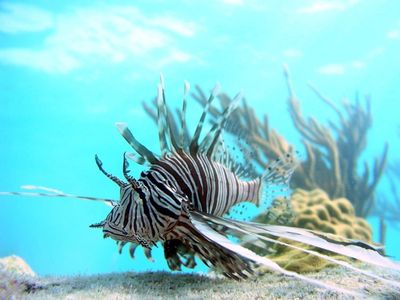Lionfish spell big trouble for sensitive Caribbean

SAN JUAN, Puerto Rico – A maroon-striped marauder with venomous spikes is rapidly multiplying in the Caribbean’s warm waters, swallowing native species, stinging divers and generally wreaking havoc on an ecologically delicate region.
The red lionfish, a tropical native of the Indian and Pacific oceans that probably escaped from a Florida fish tank, is showing up everywhere – from the coasts of Cuba and Hispaniola to Little Cayman’s pristine Bloody Bay Wall, one of the region’s prime destinations for divers.
Wherever it appears, the adaptable predator corners fish and crustaceans up to half its size with its billowy fins and sucks them down in one violent gulp.
“This may very well become the most devastating marine invasion in history,” said Mark Hixon, an Oregon State University marine ecology expert who compared lionfish to a plague of locusts. “There is probably no way to stop the invasion completely.”
A white creature with maroon stripes, the red lionfish has the face of an alien and the ribbony look of something that survived a paper shredder – with poisonous spikes along its spine to ward off enemies. The slow-moving fish measures about 18 inches. They are not aggressive toward humans, and their sting is not fatal.
The invasion is similar to that of other aquarium escapees such as walking catfish and caulerpa, a fast-growing form of algae known as “killer seaweed” for its ability to crowd out native plants.
In Africa, the Nile perch rendered more than 200 fish species extinct when it was introduced into Lake Victoria.
“Those kinds of things happen repeatedly in fresh water,” Hixon said. “But we’ve not seen such a large predatory invasion in the ocean before.”
The lionfish so far has been concentrated in the Bahamas, where marine biologists are seeing it in every habitat: in shallow and deep reefs, off piers and beaches, and perhaps most worrisome, in mangrove thickets that are vital habitats for baby fish.
Some spots in the Bahamian archipelago between New Providence and the Berry Islands are reporting a tenfold increase in lionfish just during the last year.
Northern Caribbean islands have sounded the alarm, encouraging fishermen to capture lionfish and divers to report them for eradication.
The invasion would be “devastating” to fisheries and recreational diving if it reached Puerto Rico and the U.S. Virgin Islands, according to Eugenio Pineiro-Soler of the Caribbean Fishery Management Council.
“I think at the best they will have a huge impact on reef fish, and at the worst will result in the disappearance of most reef fish,” said Bruce Purdy, a veteran dive operator who has helped the marine conservation group REEF with expeditions tracking the invasion.
Purdy said he has been stung several times while rounding up lionfish – once badly. “It was so painful, it made me want to cut my own hand off,” he said.
Researchers believe lionfish were introduced into the Atlantic in 1992, when Hurricane Andrew shattered a private aquarium and six of them spilled into Miami’s Biscayne Bay, according to the National Oceanic and Atmospheric Administration.